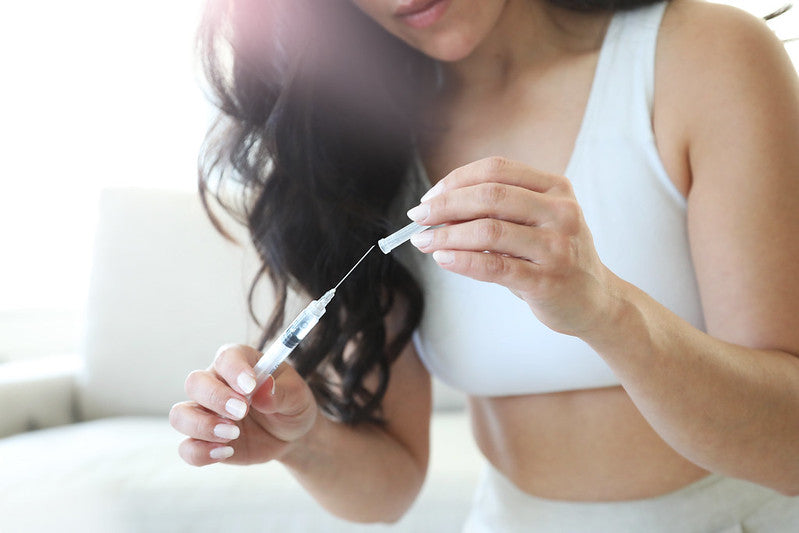Why does IVF sometimes fail? To answer this question, we need to learn more about the “IVF funnel”, which illustrates the average drop-off rate of eggs and embryos at each stage of an IVF cycle. Keep in mind that these are average rates, and many factors must be considered when calculating your unique chances of success at each step of the IVF process. Now let’s get started…
Stage 1: The Egg Retrieval (⬇ 20-30% Loss)
After you administer ovarian stimulation medications for a few days to grow the follicles, you’ll be instructed to administer a medication that triggers ovulation. Your egg retrieval will be scheduled 35-36 hours after that. The goal of these meds is to cause multiple eggs to mature inside the follicles (fluid-filled sacs) in your ovaries so multiple mature eggs can be retrieved for IVF.
It is possible to estimate how many eggs will be retrieved based on your:
- estradiol (E2) level on the day the trigger medication is administered (though certain medications can alter this level)
- number of follicles that are >16mm in diameter on the day of trigger
- age and AFC (antral follicle count, which is the number of follicles seen on ultrasound at the beginning of your cycle)
However, these values cannot definitively guarantee how many eggs will be retrieved.
For example, roughly 20% of large follicles will not contain an egg at retrieval (these are known as empty follicles). However, the number of eggs retrieved is not what truly matters, but rather the number of retrieved eggs that are mature.
An egg is considered mature if it’s progressed to a stage of development that allows it to be fertilized by a sperm. Eggs that are not mature cannot be fertilized.
On average, only 70-80% of eggs that are retrieved are mature.
It’s important to remember that during a typical menstrual cycle, only one egg matures. So it’s not unexpected that a small percentage of eggs will not properly develop even under the influence of IVF medications.
Egg maturity is evaluated prior to egg freezing or doing intracytoplasmic sperm injection (ICSI), but maturity is not checked ahead of time for eggs inseminated by conventional insemination, on which eggs and sperm are placed in a dish overnight for the sperm to reach the egg.
Stage 2: Insemination (⬇ 20-50% Loss)
Eggs are inseminated on the same day that they’re retrieved or thawed. As I explained, eggs must reach a certain level of development (be mature) in order to be fertilized by sperm.
There are two types of insemination that can be performed in IVF:
- Conventional Insemination
- ICSI (Intracytplasmic Sperm Injection)
Conventional insemination
Eggs and sperm are placed into a drop of culture medium (fluid) overnight. The hope is that one sperm will fertilize each mature egg in a process similar to natural conception. Eggs are not graded based on their maturity prior to conventional insemination.
On average, conventional insemination has a 50% fertilization rate.
However, it’s not recommended in cases of male factor infertility or previous fertilization failure. There is also a higher chance of fertilization failure (having no eggs fertilize) with conventional insemination versus ICSI.
Intracytoplasmic sperm injection (ICSI)
A single sperm is injected into each mature egg to attempt to fertilize it.
ICSI is only performed on mature eggs and has an average fertilization rate of 50-80%.
ICSI is currently the most common method of insemination in most IVF labs. It’s important to note that not all inseminated eggs will fertilize normally with either method of insemination, hence the drop-off rate of 20-50% at this stage.
Stage 3: Embryo Development (⬇ 50-70% Loss)
Quick science lesson: fertilized eggs consist of one cell, but that single cell undergoes a process known as mitosis, or cell division, by Day 2 of development (2 days after insemination). During this process, the cell will replicate its DNA (genetic material) and divide into two cells with identical DNA. These two cells then undergo mitosis to create four cells, and so on.
By Day 3, an embryo is expected to have 6-12 symmetrical cells (8+ is ideal) with less than 20% fragmentation. Embryos that display abnormal development often do not continue developing properly.
On average, around 60-80% of fertilized eggs will still be developing by Day 3.
While some labs observe and transfer embryos on Day 3, many labs wait until Day 5. At this point, the embryo should enter the blastocyst stage of development. If an embryo is still developing on day 5 but requires more time to develop further, it can be cultured for another day or two (depending on your lab’s protocol). If an embryo has not developed by this point, it’s considered arrested or non-viable.
On average, only around 30-50% of Day 3 embryos will continue developing into usable blastocysts by the end of the IVF cycle.
These embryos can be transferred into the uterus, biopsied for PGT, and/or frozen (cryopreserved).
There are many reasons why embryos do not develop properly, including:
- Genetic abnormalities within the egg, sperm, and/or embryo
- Egg and/or sperm quality issues
- Intrinsic issues inside of the embryo, such as impaired mitochondrial function
- Suboptimal culture conditions (in the lab)
Stage 4: Preimplantation Genetic Testing for Aneuploidy (PGT-A) (⬇ 45-90% Loss)
Embryos that reach the proper stages of development and have normal appearances can be biopsied for PGT. The most common type of PGT is PGT-A, which determines the percentage of an embryo’s cells that have the right number of chromosomes (the right amount of DNA).
Typical PGT-A results are as follows:
- Aneuploid embryos are abnormal; they have a high percentage of cells with the incorrect number of chromosomes
- Euploid are embryos considered to be normal; with a high percentage of cells with the correct number of chromosomes
- Mosaic embryos consist of a combination or normal and abnormal cells; some cells have the correct number of chromosomes while other cells in the biopsy do not
Aneuploid embryos often result in failed implantation, early miscarriage, and other pregnancy complications or birth defects, and aren’t recommended for transfer.
The likelihood of aneuploidy increases as the age of the mother (or egg donor) increases, but sperm quality, embryo morphology (appearance), and an embryo’s rate of development also play a role in embryo aneuploidy.
A large retrospective study calculated the chances of having at least one euploid (genetically normal) embryo in an IVF cycle based on maternal age and found that among 35-year-olds, 85% of cycles result in one or more genetically normal embryo.

The same study examined the average number of euploid (normal) Day 5 embryos obtained per IVF cycle based on maternal age. The study found that as female age increased, the average number of genetically normal embryos decreased per cycle.

The study discussed the average percentage of genetically normal embryos that are likely to occur for women between 35 and 45 years old undergoing an IVF egg retrieval cycle using their own eggs.

In general, the younger a woman is at the time of her egg retrieval, the more likely her embryos are to be genetically normal.
Stage 5: Embryo Transfer and Pregnancy Rates (⬇ 51-77% Loss)
The final stage of an IVF cycle is an embryo transfer, which involves transferring an embryo from a culture dish into your or your gestational carrier's uterus.
There are many factors that contribute to the success of an embryo transfer, including:
- The quality of the embryo(s) being transferred, as well as its genetic makeup (euploidy) and rate of development
- The uterine environment
- Systemic factors (blood clotting disorders, immunologic issues)
It’s hard to estimate your personal chance of success following an embryo transfer. The 2020 Society for Assisted Reproductive Technology (SART) National Summary Report calculated the following embryo transfer success rates based on maternal age at the time of the egg retrieval.
This did not take into account the embryo grading, PGT-A results, rate of development, etc.

This 2021 data from the CDC calculated the percentage of embryo transfers that resulted in a live birth.

Some factors that increase transfer success rates are:
- Transferring a good quality embryo
- Transferring into an optimal uterine environment
- A history of successful pregnancies
- Maternal age at the time of egg retrieval
Final thoughts about the IVF funnel
As you know now, completing an IVF cycle does not guarantee a healthy live birth, but don’t be discouraged because all of these attrition rates are averages.
It’s very possible for someone with few retrieved eggs to still have a successful cycle, just as it is possible for someone with many eggs retrieved to not have a successful cycle. Success rates depend on a lot of factors, so I always recommend asking your doctor what your particular success rate is at your IVF clinic.
Also, it’s possible to have one failed IVF cycle and a subsequent successful cycle, so don’t get discouraged if your first cycle doesn’t work. There are sometimes changes that can be made to medications and other factors that can potentially change outcomes in future cycles.
It takes an average of 2.5 IVF cycles to achieve a pregnancy, so it’s important to set realistic expectations. Though many people find success with IVF, not everyone does. Try not to compare your results to others since everyone’s bodies, medical histories, and journeys are very different.
Again, there are no guarantees in IVF, but if you’re looking for ways to improve your success rates, lifestyle modifications are the most evidence-based approaches, such as:
- Maintain a healthy diet
- Drink plenty of water
- Get plenty of sleep
- Try to avoid stress
- Talk with your doctor about supplements that may help improve egg and/or sperm quality
- Make sure that you have had a workup done to rule out any conditions such as PCOS, uterine polyps or fibroids, as well as abnormal sperm production in the male partner
- Keep up with your overall health so your hormones are balanced
- Maintain an exercise routine and a healthy weight
And perhaps most importantly: Do your research! Learn about fertility and reproduction from reputable sources (like Dandi's fertility nurse team) and ask your doctor questions about whatever you don’t understand. Good luck!







